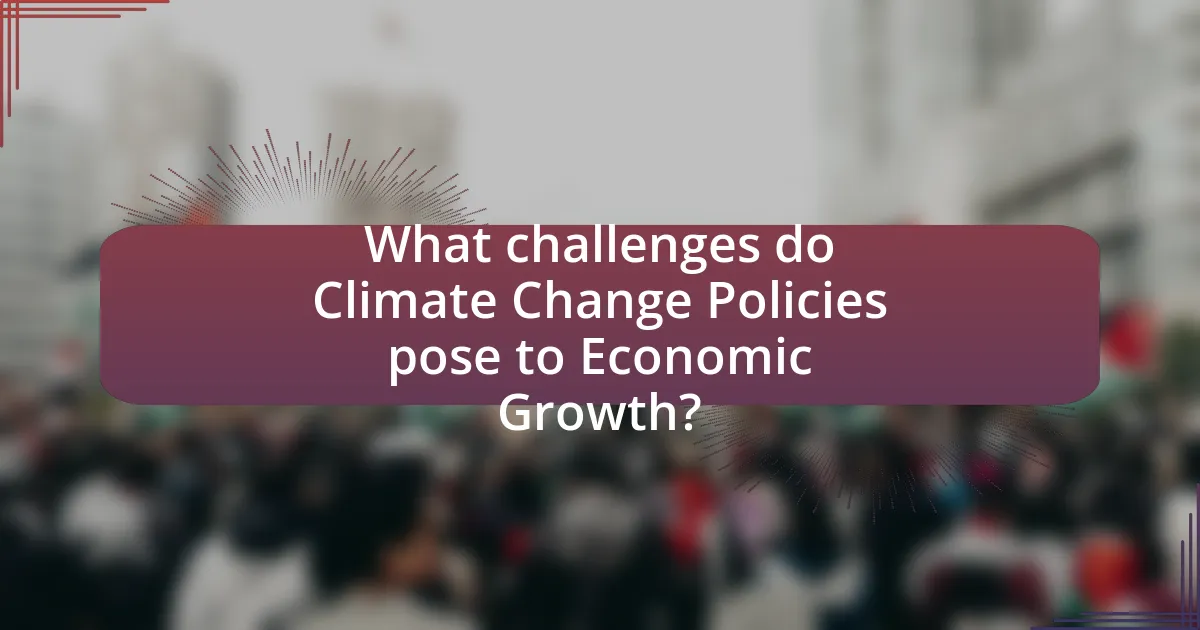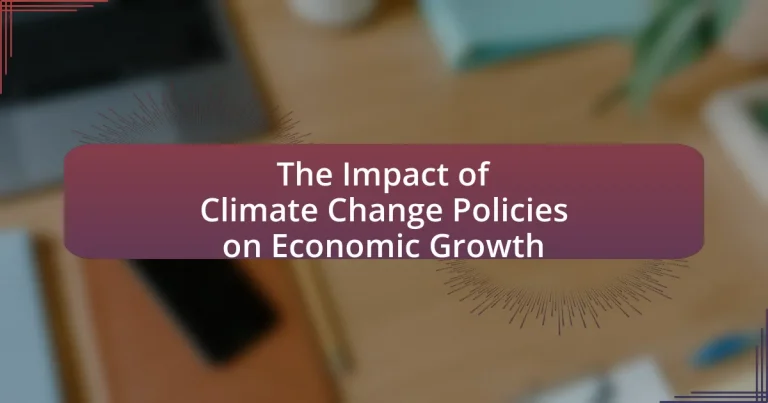Climate change policies are strategic frameworks established by governments and organizations to address the impacts of climate change while promoting sustainability and economic growth. These policies aim to reduce greenhouse gas emissions, enhance energy efficiency, and foster renewable energy sources, with specific targets set for emissions reductions by 2030 and beyond. The article explores how these policies influence economic growth, job creation, and innovation in green technologies, while also addressing the challenges and potential economic drawbacks associated with stringent regulations. Additionally, it examines the roles of local and national governments, the impact of international agreements, and the importance of public support in the successful implementation of climate initiatives.

What are Climate Change Policies and Their Objectives?
Climate change policies are strategic frameworks implemented by governments and organizations to mitigate the effects of climate change and promote sustainability. Their primary objectives include reducing greenhouse gas emissions, enhancing energy efficiency, promoting renewable energy sources, and fostering climate resilience in communities and ecosystems. For instance, the Paris Agreement, adopted in 2015, aims to limit global warming to well below 2 degrees Celsius, emphasizing the need for countries to set and achieve nationally determined contributions (NDCs) to reduce emissions. These policies are essential for transitioning to a low-carbon economy, protecting public health, and ensuring long-term economic stability by addressing the risks associated with climate change.
How do Climate Change Policies aim to mitigate environmental impacts?
Climate change policies aim to mitigate environmental impacts by implementing regulations and incentives that reduce greenhouse gas emissions and promote sustainable practices. These policies often include carbon pricing mechanisms, such as carbon taxes or cap-and-trade systems, which create financial incentives for businesses to lower their emissions. For instance, the European Union’s Emissions Trading System has successfully reduced emissions by approximately 35% since its inception in 2005. Additionally, policies that promote renewable energy sources, such as wind and solar, help decrease reliance on fossil fuels, further reducing environmental degradation. By fostering energy efficiency and conservation measures, these policies contribute to a significant reduction in pollution and habitat destruction, ultimately leading to a healthier ecosystem.
What specific goals do these policies set for greenhouse gas emissions?
These policies set specific goals to reduce greenhouse gas emissions by targeting a significant decrease in overall emissions levels, often aiming for a reduction of 40% to 50% by 2030 compared to 1990 levels. For instance, the European Union’s Green Deal aims for net-zero emissions by 2050, while the United States has committed to a 50-52% reduction by 2030 relative to 2005 levels. These targets are supported by scientific consensus indicating that such reductions are necessary to limit global warming to 1.5 degrees Celsius, as outlined in the Intergovernmental Panel on Climate Change reports.
How do these policies promote renewable energy sources?
Climate change policies promote renewable energy sources by providing financial incentives, regulatory frameworks, and research funding that encourage investment in clean technologies. For instance, subsidies and tax credits for solar and wind energy projects lower the cost of renewable energy production, making it more competitive with fossil fuels. According to the International Renewable Energy Agency, global renewable energy capacity increased by 10.3% in 2020, largely due to supportive policies. Additionally, mandates for renewable energy usage in power generation compel utilities to integrate more sustainable sources into their energy mix, further driving demand and innovation in the sector.
What role do governments play in implementing Climate Change Policies?
Governments play a crucial role in implementing climate change policies by establishing regulations, providing funding, and facilitating international agreements. They create legal frameworks that mandate emissions reductions, promote renewable energy, and enforce environmental standards. For instance, the Paris Agreement, which was adopted by nearly 200 countries, relies on national governments to set and achieve their climate targets. Additionally, governments allocate public funds for research and development in clean technologies, which can drive economic growth while addressing climate change. According to the International Renewable Energy Agency, investments in renewable energy can create millions of jobs globally, demonstrating the economic benefits of effective climate policies.
How do international agreements influence national policies?
International agreements influence national policies by establishing frameworks and commitments that countries must adhere to, often leading to legislative and regulatory changes at the national level. For instance, the Paris Agreement requires signatory nations to set and achieve specific greenhouse gas emission reduction targets, prompting many countries to implement policies that promote renewable energy and energy efficiency. This alignment with international standards can drive innovation and investment in green technologies, ultimately impacting economic growth. Research by the Global Commission on the Economy and Climate indicates that transitioning to a low-carbon economy could generate over $26 trillion in economic benefits by 2030, demonstrating the significant influence of international agreements on national policy and economic outcomes.
What are the responsibilities of local governments in climate action?
Local governments are responsible for implementing climate action initiatives that address local environmental challenges and promote sustainability. These responsibilities include developing and enforcing regulations that reduce greenhouse gas emissions, such as building codes that enhance energy efficiency and zoning laws that encourage sustainable land use. Additionally, local governments are tasked with creating climate action plans that outline specific goals and strategies for reducing carbon footprints, often involving community engagement and collaboration with stakeholders.
For instance, according to the Global Covenant of Mayors for Climate and Energy, local governments play a crucial role in achieving global climate targets by setting measurable objectives and reporting progress. Furthermore, local governments can facilitate the transition to renewable energy sources by investing in infrastructure and providing incentives for businesses and residents to adopt clean technologies. This multifaceted approach not only addresses climate change but also fosters economic growth by creating green jobs and attracting investments in sustainable practices.
What are the potential economic impacts of Climate Change Policies?
Climate Change Policies can lead to significant economic impacts, including both costs and benefits. These policies often require substantial investments in renewable energy, infrastructure, and technology, which can stimulate job creation and economic growth in green sectors. For instance, a report by the International Renewable Energy Agency (IRENA) indicates that transitioning to renewable energy could create up to 24 million jobs globally by 2030. However, there are also potential costs associated with these policies, such as increased energy prices and economic disruptions in fossil fuel-dependent industries. The World Bank estimates that the transition could lead to a short-term economic slowdown in regions heavily reliant on fossil fuels, but long-term benefits include reduced climate-related damages and improved public health outcomes, which can enhance overall economic productivity.
How can these policies affect job creation in various sectors?
Climate change policies can significantly affect job creation across various sectors by promoting green technologies and sustainable practices. For instance, investments in renewable energy, such as solar and wind, have been shown to create more jobs per unit of electricity generated compared to fossil fuels. According to the International Renewable Energy Agency, the renewable energy sector employed over 11 million people globally in 2018, and this number is projected to continue growing as countries implement stricter climate policies. Additionally, energy efficiency measures and sustainable agriculture practices can lead to job creation in construction, manufacturing, and farming sectors, as businesses adapt to new regulations and consumer demands for environmentally friendly products. Thus, climate change policies not only drive innovation but also stimulate employment opportunities across diverse industries.
What are the implications for businesses and industries?
The implications for businesses and industries due to climate change policies include increased operational costs, shifts in market demand, and the necessity for innovation. Businesses face higher expenses related to compliance with regulations aimed at reducing carbon emissions, which can affect profit margins. For instance, the implementation of carbon pricing mechanisms can lead to increased costs for fossil fuel-dependent industries. Additionally, as consumers become more environmentally conscious, there is a growing demand for sustainable products and services, prompting industries to adapt their offerings. A report by the World Economic Forum indicates that companies investing in sustainability can achieve a competitive advantage, as 66% of consumers are willing to pay more for sustainable brands. Therefore, businesses must navigate these changes to remain viable and competitive in a rapidly evolving economic landscape influenced by climate change policies.

How do Climate Change Policies influence Economic Growth?
Climate change policies influence economic growth by promoting sustainable practices and innovation while potentially imposing costs on certain industries. These policies, such as carbon pricing and renewable energy incentives, encourage investment in green technologies, which can lead to job creation and economic diversification. For instance, a study by the International Renewable Energy Agency found that transitioning to renewable energy could create 24 million jobs globally by 2030. However, the implementation of stringent regulations may also lead to short-term economic disruptions in fossil fuel-dependent sectors, affecting overall growth rates. Thus, while climate change policies can drive long-term economic benefits through innovation and sustainability, they may also present challenges that need to be managed for balanced economic growth.
What are the short-term economic effects of implementing these policies?
The short-term economic effects of implementing climate change policies include increased government spending, job creation in green sectors, and potential disruptions in traditional industries. Government spending on renewable energy projects and infrastructure can stimulate economic activity, leading to job creation in sectors such as solar and wind energy. For instance, a report by the International Renewable Energy Agency (IRENA) indicated that transitioning to renewable energy could create millions of jobs globally within a few years. However, these policies may also lead to short-term job losses in fossil fuel industries, creating economic disruptions in regions reliant on those sectors. The balance between job creation and loss can significantly influence local economies and overall economic growth in the short term.
How do initial costs compare to long-term benefits?
Initial costs of implementing climate change policies are often high, but they are outweighed by significant long-term benefits. For instance, investing in renewable energy infrastructure may require substantial upfront capital, yet studies show that such investments can lead to reduced energy costs, job creation, and improved public health over time. According to a report by the International Renewable Energy Agency, transitioning to renewable energy could save the global economy up to $160 trillion by 2050 through lower energy costs and reduced health expenditures. Thus, while initial costs may be daunting, the long-term economic and environmental benefits provide a compelling justification for these investments.
What sectors experience immediate economic changes?
The sectors that experience immediate economic changes due to climate change policies include energy, transportation, and agriculture. These sectors are directly impacted by regulations aimed at reducing carbon emissions and promoting sustainability. For instance, the energy sector faces rapid shifts as governments implement policies to transition from fossil fuels to renewable energy sources, leading to significant investments in solar and wind technologies. In transportation, the push for electric vehicles and public transit improvements results in immediate changes in manufacturing and infrastructure. Agriculture is affected by policies promoting sustainable practices, which can alter production methods and crop choices. These immediate changes are evidenced by the rapid growth of renewable energy jobs, which increased by 11% globally in 2018, according to the International Renewable Energy Agency.
What are the long-term economic impacts of sustained Climate Change Policies?
Sustained climate change policies can lead to significant long-term economic impacts, including the promotion of green technologies and the transition to sustainable energy sources. These policies often stimulate innovation, resulting in job creation in renewable energy sectors; for instance, the International Renewable Energy Agency reported that the renewable energy sector employed over 11 million people globally in 2018, a number that continues to grow as policies are implemented. Additionally, sustained climate policies can mitigate the economic costs associated with climate-related disasters, which, according to the National Oceanic and Atmospheric Administration, caused over $1 trillion in damages in the U.S. alone from 1980 to 2020. By investing in resilience and adaptation strategies, economies can reduce future expenditures related to climate impacts, ultimately fostering a more stable economic environment.
How do these policies contribute to sustainable economic development?
Climate change policies contribute to sustainable economic development by promoting green technologies and reducing carbon emissions. These policies incentivize investments in renewable energy sources, such as solar and wind, which create jobs and stimulate economic growth. For instance, the International Renewable Energy Agency reported that the renewable energy sector employed over 11 million people globally in 2018, demonstrating the job creation potential of these policies. Additionally, by mitigating the impacts of climate change, such as extreme weather events, these policies help protect infrastructure and reduce economic losses, further supporting long-term economic stability.
What is the relationship between climate resilience and economic stability?
Climate resilience directly contributes to economic stability by reducing vulnerability to climate-related disruptions. When communities and economies are better equipped to withstand climate impacts, such as extreme weather events, they experience less economic loss and can maintain productivity. For instance, a study by the Global Commission on Adaptation found that investing in climate resilience measures could yield benefits of up to $7 trillion globally by 2030, highlighting the economic advantages of proactive adaptation strategies. This relationship underscores that enhancing climate resilience not only protects livelihoods but also fosters sustainable economic growth.
How do Climate Change Policies affect innovation and technology?
Climate change policies drive innovation and technology by creating regulatory frameworks that incentivize the development of sustainable solutions. These policies often include financial incentives, such as tax credits and grants, which encourage businesses to invest in research and development of clean technologies. For instance, the implementation of the Renewable Energy Standard in various countries has led to significant advancements in solar and wind technologies, resulting in a 90% reduction in the cost of solar energy since 2009, according to the International Renewable Energy Agency. Furthermore, climate policies stimulate competition among firms to innovate, leading to the emergence of new markets and job opportunities in green technology sectors.
What role does government funding play in green technology advancements?
Government funding plays a crucial role in advancing green technology by providing financial resources necessary for research, development, and deployment of sustainable innovations. This funding enables startups and established companies to develop technologies such as renewable energy systems, energy-efficient products, and carbon capture solutions. For instance, the U.S. Department of Energy allocated over $35 billion in 2021 for clean energy initiatives, which significantly accelerated advancements in solar and wind technologies. Such investments not only foster innovation but also create jobs and stimulate economic growth, demonstrating the direct impact of government funding on the green technology sector.
How do these policies stimulate research and development in clean energy?
Climate change policies stimulate research and development in clean energy by providing financial incentives, regulatory frameworks, and public funding that encourage innovation. For instance, government grants and tax credits for renewable energy projects lower the financial barriers for companies and researchers, enabling them to invest in new technologies. According to a report by the International Renewable Energy Agency, global investment in renewable energy reached $300 billion in 2020, largely driven by supportive policies. Furthermore, regulations that mandate emissions reductions compel industries to seek cleaner alternatives, fostering a competitive environment for clean energy solutions. This combination of financial support and regulatory pressure creates a robust ecosystem for advancing clean energy research and development.

What challenges do Climate Change Policies pose to Economic Growth?
Climate change policies pose significant challenges to economic growth by imposing regulatory costs and altering market dynamics. These policies often require substantial investments in renewable energy and infrastructure, which can strain public and private finances. For instance, the International Energy Agency reported that achieving net-zero emissions by 2050 would require an annual investment of around $4 trillion, potentially diverting funds from other economic activities. Additionally, stringent regulations can lead to increased operational costs for businesses, impacting their competitiveness and profitability. The transition to greener technologies may also result in job losses in traditional sectors, creating social and economic disruptions.
What are the potential economic drawbacks of stringent climate regulations?
Stringent climate regulations can lead to significant economic drawbacks, including increased costs for businesses and potential job losses in certain sectors. These regulations often require companies to invest heavily in new technologies or processes to comply, which can raise operational costs and reduce competitiveness. For instance, a study by the National Association of Manufacturers indicated that stringent regulations could lead to a loss of 1.4 million manufacturing jobs by 2030 due to increased compliance costs. Additionally, higher energy prices resulting from regulations can reduce disposable income for consumers, further impacting economic growth.
How can compliance costs impact small businesses?
Compliance costs can significantly impact small businesses by increasing their operational expenses and reducing profitability. These costs arise from adhering to regulations, such as environmental standards related to climate change policies. For instance, a study by the National Federation of Independent Business found that small businesses spend an average of $12,000 annually on compliance-related activities. This financial burden can limit their ability to invest in growth, hire new employees, or innovate, ultimately hindering their competitiveness in the market.
What are the risks of economic displacement in traditional industries?
Economic displacement in traditional industries poses significant risks, including job loss, reduced income, and community destabilization. As climate change policies promote a shift towards sustainable practices, industries reliant on fossil fuels and non-renewable resources face decline. For instance, the coal industry has seen a dramatic reduction in jobs, with the U.S. Bureau of Labor Statistics reporting a decrease from over 90,000 jobs in 2011 to around 40,000 in 2021, largely due to regulatory changes and market shifts towards renewable energy. This transition can lead to economic instability in regions dependent on these industries, resulting in increased unemployment rates and diminished local economies. Additionally, the skills gap between traditional and emerging industries can exacerbate the challenges faced by displaced workers, making it difficult for them to transition into new roles.
How do public perceptions and political factors influence the effectiveness of these policies?
Public perceptions and political factors significantly influence the effectiveness of climate change policies by shaping the level of public support and legislative action. When the public perceives climate change as a critical issue, there is often greater demand for robust policies, leading to stronger governmental commitment and implementation. For instance, surveys indicate that in countries where a majority of the population acknowledges climate change as a serious threat, such as in Sweden and Germany, there is a higher likelihood of enacting comprehensive climate policies that promote economic growth through green technologies. Conversely, in regions where skepticism about climate change prevails, such as in parts of the United States, political leaders may prioritize short-term economic interests over long-term sustainability, resulting in weaker policies and reduced effectiveness. This dynamic illustrates how public opinion can drive political agendas, ultimately affecting the success of climate initiatives aimed at fostering economic growth.
What role does public support play in the success of climate initiatives?
Public support is crucial for the success of climate initiatives, as it drives political will, funding, and community engagement. When the public actively supports climate policies, governments are more likely to implement and sustain these initiatives, leading to effective action against climate change. For instance, a study by the Yale Program on Climate Change Communication found that 70% of Americans support government action on climate change, which correlates with increased legislative efforts and funding for renewable energy projects. This demonstrates that public backing not only influences policy decisions but also enhances the overall effectiveness of climate initiatives by fostering a collaborative environment for implementation and innovation.
How can political opposition hinder economic growth related to climate policies?
Political opposition can hinder economic growth related to climate policies by creating uncertainty and instability in regulatory frameworks. When political factions oppose climate initiatives, they can lead to inconsistent policies that deter investment in renewable energy and sustainable practices. For example, the lack of a stable policy environment can result in a 30% decrease in private sector investment in clean energy projects, as seen in regions where political opposition has led to the rollback of supportive measures. This uncertainty can also slow down innovation and job creation in green technologies, ultimately stunting economic growth that could arise from a transition to a low-carbon economy.
What strategies can be employed to maximize the economic benefits of Climate Change Policies?
To maximize the economic benefits of Climate Change Policies, governments and organizations can implement strategies such as investing in renewable energy, promoting energy efficiency, and fostering innovation in green technologies. Investing in renewable energy sources like solar and wind can create jobs and stimulate economic growth; for instance, the International Renewable Energy Agency reported that the renewable energy sector employed over 11 million people globally in 2018. Promoting energy efficiency through regulations and incentives can reduce costs for businesses and consumers, leading to increased disposable income and spending. Additionally, fostering innovation in green technologies can drive economic growth by creating new markets and industries; a report from the Global Commission on the Economy and Climate indicated that transitioning to a low-carbon economy could generate $26 trillion in economic benefits by 2030. These strategies collectively enhance economic resilience while addressing climate change.
How can policymakers balance environmental goals with economic growth?
Policymakers can balance environmental goals with economic growth by implementing sustainable development strategies that promote green technologies and renewable energy. For instance, investing in clean energy sectors not only reduces carbon emissions but also creates jobs; the International Renewable Energy Agency reported that the renewable energy sector employed over 11 million people globally in 2018. Additionally, integrating environmental regulations that incentivize businesses to adopt eco-friendly practices can lead to innovation and efficiency, ultimately driving economic growth while protecting natural resources.
What best practices can be adopted to ensure a smooth transition to a green economy?
To ensure a smooth transition to a green economy, adopting comprehensive policy frameworks that integrate sustainability into economic planning is essential. These frameworks should include incentives for renewable energy adoption, such as tax credits and subsidies, which have been shown to increase investment in clean technologies. For instance, the International Renewable Energy Agency reported that countries implementing such incentives have seen a significant rise in renewable energy capacity, contributing to job creation and economic growth. Additionally, fostering public-private partnerships can facilitate innovation and resource sharing, enhancing the efficiency of green initiatives. Evidence from the European Union’s Green Deal indicates that collaborative efforts between governments and businesses can lead to more effective implementation of sustainable practices, ultimately driving economic resilience while addressing climate change.





